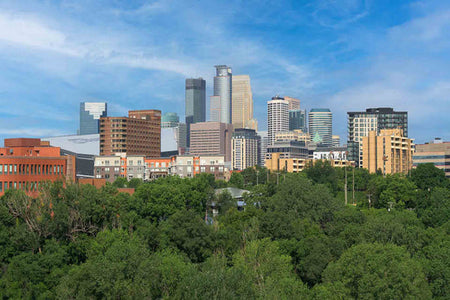- Allergy season in Texas can last year-round, with different regions experiencing peaks in allergens at various times.
- Common Texas allergens include cedar, oak, elm, ash, and pecan trees, Bermuda grass, ragweed, and mold spores, all of which contribute to seasonal allergies.
- Simple steps to manage Texas allergies include monitoring pollen levels, staying indoors during peak times, and starting allergy medications early.
Texas is known for its beautiful landscapes, lively culture, and warm weather, which makes it a great place to live. Whether in busy cities or the peaceful countryside, the state has something for everyone.
But for people with seasonal allergies, Texas can be tricky. The different areas of the state have different allergy seasons, so it’s important to know when allergy season starts, peaks, and ends to help manage symptoms.
When is Allergy Season in Texas?
Allergy seasons in Texas can last all year with different regions experiencing peaks in allergens at various times.
When is Allergy Season Central Texas?
In Central Texas, cedar pollen (from mountain cedar) season begins in late December and lasts through February. Spring brings tree pollen from February to May, followed by grass pollen from April through September. In late summer and fall, ragweed pollen is common and often lasts until the first frost.
When is Allergy Season in North Texas?
Similar to Central Texas, the cedar season in North Texas runs from late December through February, though it’s usually less intense. Tree pollen peaks from February through May, and grass pollen is common from April to September. Ragweed pollen typically starts in August and can last until November or the first frost.
When is Allergy Season in East Texas?
East Texas, with its warm, humid climate, also experiences an extended allergy season. Tree pollen starts in February and lasts through May, with grass pollen from April through September. Ragweed is a major allergen from August until November, similar to other regions. The area’s humidity often makes pollen feel more intense.
When is Allergy Season in West Texas?
West Texas allergy season is shorter due to the drier climate. Tree pollen generally peaks from February to April, with less grass pollen than in other regions. Ragweed and other weed pollen appear from August to October but are typically lighter due to fewer plants in the region.
What are the Worst Months for Allergies in Texas?
The worst months for allergies in Texas vary on region and the type of pollen in each season, but peak allergy months generally include:
- January to February. Cedar pollen is a major allergen in Central Texas during winter, and it causes intense allergy symptoms and "cedar fever." This period is especially challenging for residents in cities like Austin and San Antonio. Symptoms of cedar fever include stuffy nose, coughing, sore throat, mild fever, and fatigue [*].
- March to May. During spring, tree pollen becomes a major allergen across Texas. Pollen from oak, elm, and ash trees make these months tough for allergy sufferers statewide. Tree pollen is especially high in March and April. Note that live oak trees produce a lot of pollen. The male flowers, called catkins, release large amounts of yellow pollen into the air. This pollen can cover cars, sidewalks, and other nearby surfaces.
- September to October. Fall is another peak allergy time due to ragweed pollen, which affects many parts of Texas, especially East and North Texas. Ragweed can spread last until the first frost, which makes symptoms severe during these months. Ragweed pollen is very light and can travel long distances, sometimes up to 400 miles [*][*]. So, even if you don’t live near many ragweed plants, you can still be affected by its pollen.
These months often have the highest pollen counts in Texas. As a result, people with seasonal allergies may experience worsened symptoms, such as sneezing, itchy eyes, and congestion, because the allergens are more widespread.
When Does Pollen Season End in Texas?
Allergy season in Texas usually ends around November, but it can be different depending on the area and the weather. Ragweed and other weeds are the last allergens to cause problems — they peak in the fall and usually get better after the first frost.
In Central and East Texas, where winters aren’t as cold, allergy season can last a little longer if the frost comes late. However, when colder weather hits in late November or early December, it helps lower pollen levels and gives relief to allergy sufferers.
Common Allergens in Texas
Here are some of the most common allergens found throughout the state of Texas:
- Cedar trees
- Juniper trees
- Oak trees
- Elm trees
- Ash trees
- Pecan trees
- Bermuda grass
- Johnson grass
- Ragweed
- Mold Spores (can be a major indoor and outdoor allergen, particularly during damp conditions)
Texas Allergies Symptoms
Allergies in Texas can cause a variety of symptoms, depending on your sensitivity. Here are some common Texas allergy symptoms you may experience:
- Sneezing
- Congestion
- Runny nose
- Itchy, watery eyes
- Postnasal drip
- Coughing
- Headaches
- Fatigue
How to Prepare for Texas Allergy Season
Preparing ahead of time for Texas allergy season involves taking steps to minimize discomfort. Here’s how you can plan accordingly:
- Monitor pollen counts. This means keeping track of the amount of pollen in the air, which is usually reported daily or weekly in local pollen forecasts or allergy apps. Knowing the pollen count is important because it helps you plan your activities.
- Limit outdoor exposure. Pollen counts are usually at their highest in the early morning hours, so it’s a good idea to stay indoors during this time if you have allergies. If you do need to go outside, try to keep it brief and avoid areas with lots of trees, grasses, or flowers that produce pollen.
- Use air purifiers. Air purifiers help clean the air inside your home by removing allergens like pollen, dust, and pet dander. Those with HEPA filters are especially effective because they trap tiny particles. Be sure to change the filters regularly to keep the purifier working well.
- Keep your home clean. Regularly clean your home to reduce dust and pollen. Use a vacuum cleaner with a HEPA filter, wipe down surfaces and counters with a damp cloth, and wash bedding in hot water once a week to remove pollen and dust mites that can collect.
- Take medications. Medications like antihistamines and nasal sprays can help reduce common allergy symptoms such as sneezing, itching, and congestion. One option you might want to consider is Allermi, a combination therapy nasal spray that contains the medications you need, combined at the right percentages for a tailored dosage. This formulation helps provide fast and effective relief.
- Wear a mask and sunglasses. Wear protective gear to help reduce your exposure to allergens, especially when you need to go outside. Masks can be especially helpful when doing outdoor activities like walking, gardening, or exercising.
- Shower and change clothes after being outside. Pollen can easily stick to your hair, skin, and clothing when you spend time outdoors, even if you don’t notice it immediately. Showering can wash away pollen while changing into fresh clothes after being outside helps remove any pollen that may have clung to your clothing.
- Consider allergy shots. If your allergies are severe, discuss the option of allergy shots (immunotherapy) with your allergist. This treatment can help desensitize you to specific allergens over time.
These are simple steps that, when followed consistently, can help you manage your seasonal allergies in Texas.
The Bottom Line
Simple steps like wearing protective gear, showering after being outside, and using a combination nasal spray like Allermi can go a long way in reducing your Texas allergy burden.
Always be vigilant and proactive, and consult with your healthcare provider to make sure your allergy management is as effective as possible.
References:
- Cedar Fever. (2024b, May 1). Cleveland Clinic. https://my.clevelandclinic.org/health/diseases/25120-cedar-fever
- Ragweed Allergies - Allergy & Asthma Network. (n.d.). Allergy & Asthma Network. https://allergyasthmanetwork.org/allergies/pollen-allergy/ragweed-allergy/
- Oswalt, M. L., & Marshall, G. D. (2008). Ragweed as an example of worldwide allergen expansion. Allergy, asthma, and clinical immunology : official journal of the Canadian Society of Allergy and Clinical Immunology, 4(3), 130–135. https://doi.org/10.1186/1710-1492-4-3-130









